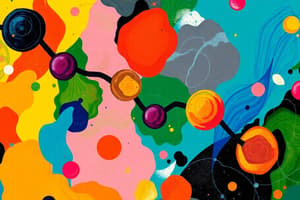Podcast
Questions and Answers
What is drug metabolism?
What is drug metabolism?
The process by which the body converts xenobiotics into a less toxic, more polar form that can be readily excreted.
Where does the largest proportion of drug metabolism take place?
Where does the largest proportion of drug metabolism take place?
- Intestine
- Liver (correct)
- Kidney
- Lung
Drugs can access metabolizing enzymes directly through the skin.
Drugs can access metabolizing enzymes directly through the skin.
False (B)
What is the first pass effect?
What is the first pass effect?
Which of the following is a possible metabolic pathway for active drugs?
Which of the following is a possible metabolic pathway for active drugs?
The _____ is a well perfused organ that aids in drug metabolism.
The _____ is a well perfused organ that aids in drug metabolism.
Heroin is converted to which active metabolite?
Heroin is converted to which active metabolite?
What is a prodrug?
What is a prodrug?
Flashcards are hidden until you start studying
Study Notes
Drug Metabolism
- The body converts foreign substances, like drugs, into a less toxic, more polar form for excretion.
- The liver is the primary organ for drug metabolism.
- Other organs involved in drug metabolic reactions include the lungs, kidneys, intestines, skin, and placenta.
- The liver is rich in drug metabolizing enzymes and well-perfused, allowing drugs to access these enzymes.
- Orally administered drugs pass through the liver before entering the systemic circulation, influencing metabolism. This is known as the first-pass effect.
Drug Metabolism Possibilities
-
Active drug → Inactive metabolite(s): The most common metabolic pathway. The example, Tolbutamide, is an oral hypoglycemic agent that is converted to an inactive carboxylic acid metabolite through oxidation.
-
Active drug → Active metabolite(s): Co-activation where the drug is metabolized into a more active form. Heroin is four times more active than its metabolite morphine. Heroin is converted to morphine by hydrolysis.
-
Active drug → Toxic metabolite(s): Metabolic toxicity where the drug metabolism results in a toxic substance. Diethyl stilbsterol (DES), an anti-cancer drug, can be converted into a carcinogenic epoxide metabolite.
-
Inactive drug → Active metabolite(s): Prodrugs are inactive drugs that are converted into active metabolites within the body. Prontosil red is inactive but is converted by reduction to the active antimicrobial sulphanilamide.
Studying That Suits You
Use AI to generate personalized quizzes and flashcards to suit your learning preferences.





